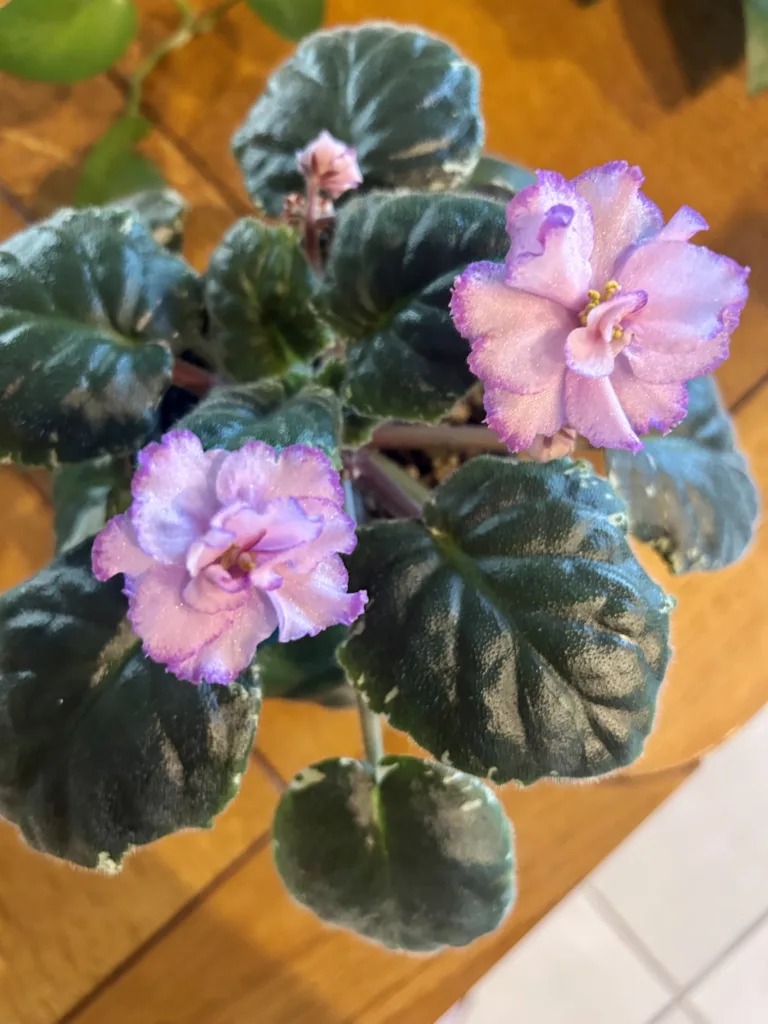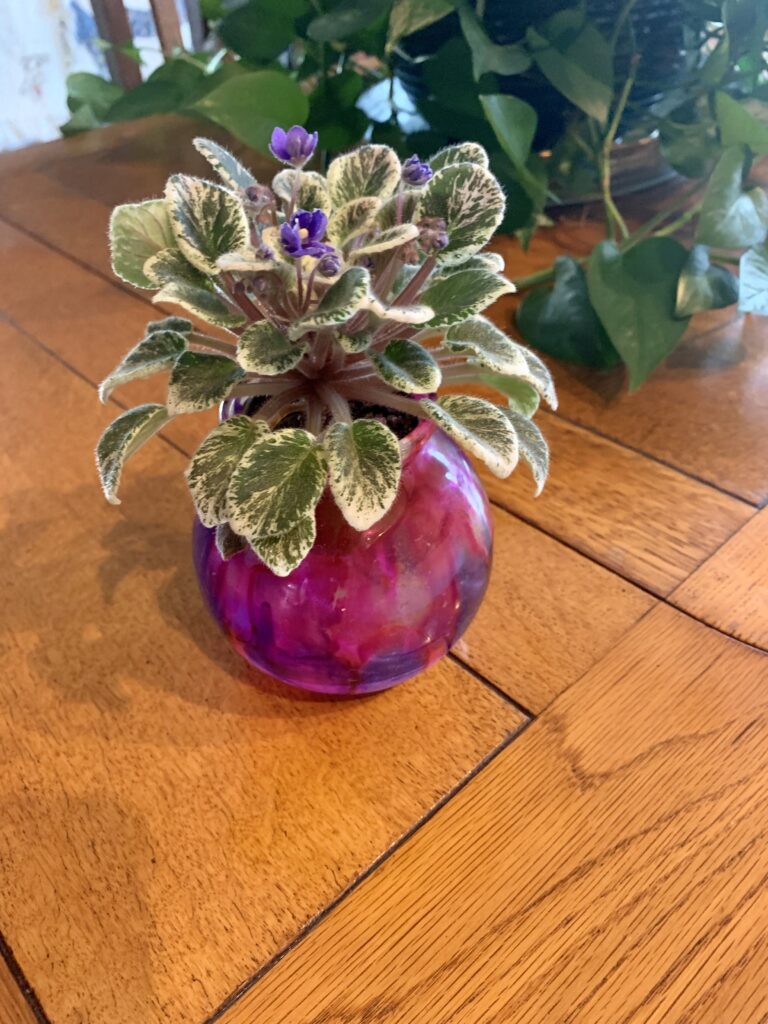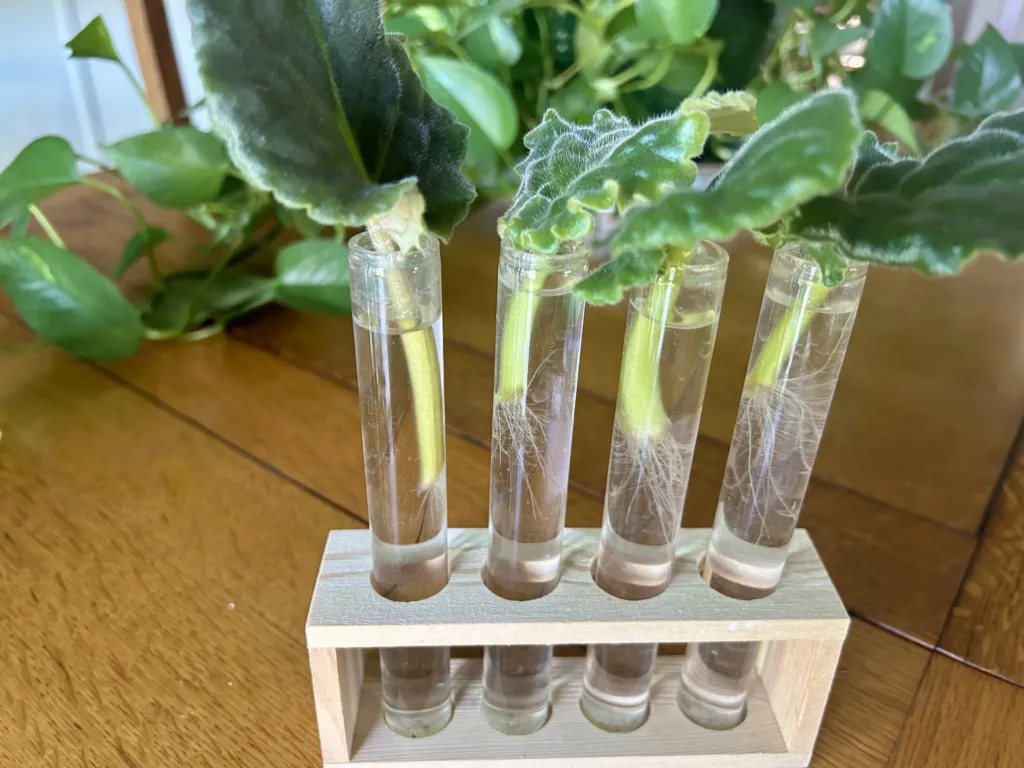
Discovering and nurturing the beauty of Variegated African Violets, with their unique colored foliage, is a rewarding experience for any African Violet gardener. The beauty of just the foliage in the Variegated AV is enjoyed even without the blooms!
These Violets are easy to care for, however, they require the same attention as regular African Violets. Including light requirements, soil type, and moisture level when it comes to successful growth. With proper management, you can enjoy vibrant plants year-round as well as propagate them yourself by taking cuttings or removing suckers. Read on to find out all the secrets behind these magical plants. And how you can create your stunning display of Variegated African Violets in no time.
African Violet Variegated Leaves
Variegated African Violets are beloved among African Violet gardeners for their variegated leaves that can be enjoyed even without the blooms These beautiful leaves come in many hues including colors like cream, yellow, pink, white, yellow, lavender, and shades of green. To grow variegated African Violets, the gardener must be sure to provide ample indirect light, fertilizer, moist soil with good drainage, and frequent watering. Understanding how to propagate this houseplant is relatively easy as well: through leaf cuttings or removing suckers.

Controlling the Amount of Varigation
Variegation of African Violets can be controlled by providing the correct conditions. To ensure that Variegated AVs maintain their desirable variegation, control the temperature. Most Variegated AVs maintain a good color balance at 72 degrees F. Warmer temperatures produce a greener color and cooler temps produce more variegation. You might want to invest in a temperature monitor like this Thermapro to monitor your temps for not only your Variegated but also standard AVs.
Lighting for African Violets
Variegated African Violets just like regular African Violets thrive in bright, indirect light. The best lighting for these plants is provided by a south-facing window. Because it provides the most consistent source of light throughout the day. Although I have mine in the south, north, and west windows. I just close the blinds part way to avoid direct sunlight, you can also use sheer curtains to filter the light.
If growing indoors with little to no light fluorescent or LED lights are a great alternative. However, they should be placed at least 12 inches away from the plant, and up to 12 hours a day. I love these FoxGarden LED lights and have them on both a shelf of miniatures and one full of standard violets in my kitchen away from any windows. Too little light can cause the leaves to become dull in color, while too much light will quickly cause them to wither and die.
African Violet Soil
Variegated African Violets need a soil that drains quickly yet still retains some moisture. A potting mix specifically designed for African Violets is recommended. Choices like Black Gold African Violet soil, Epsoma African Violet soil or Miracle Grow African Violet soil are great choices. I used all of them when I started out. Although now, I have so many violets that I like to mix my own. I use 1 part perlite, 1 part vermiculite and 2 parts sphagnum peat moss.
African Violet Pots
The best pot type for African Violets is a ceramic, terracotta or plastic pot with several holes in the bottom for good drainage. This allows excess water to be released and prevents root rot from occurring. It is important when selecting a pot that it have adequate drainage holes as African Violets are prone to root rot if overwatered.
Some people swear by terracotta although, I have a majority of mine in plastic on water wicking (method described below). The others are in Ceramic African Violet pots. Every AV is different so if not thriving in the pot you have it in, switch it up and see if it likes a different type pot better. I have some that the leaves become limp and the plant becomes waterlogged in a ceramic AV pot. Then when I switch to water wicking they thrive and vice versa. So see which pot they like best-trust me they will let you know when they are not happy!
Watering African Violets
Variegated African Violets just like regular African Violets are sensitive to both over and under-watering. Some believe it’s best to water from the bottom, using a shallow dish or tray filled with room-temperature water. The soil should be kept consistently moist, but not soggy. Allow the top inch of soil to dry out before watering again. Others like to water from the top but be sure to avoid getting water on the leaves.
I prefer Water wicking method, most of my AVs, regular and variegated are in water-wicking pots. I use this 4″ plastic pot in which I can write the name of the violet with a sharpie. Then I place one of these 2-4″ screens over the holes in the bottom so the soil does not fall into the water. Next I put a piece of acrylic yarn that I divide into three strands (so as not to take up too much water) long enough to go from the top of the pot down into the water. Then I place the potted violet into one of these bowl vases that fill with water just below the bottom of the pot. This keeps the soil moist but not too wet.
Fertilizing African Violets
Variegated African Violets require a balanced fertilizer specifically formulated for African Violets. Generally, I recommend using a liquid fertilizer once every two weeks in spring and summer, then only once a month during fall and winter. Be sure to follow the directions on the bottle as too much fertilizer can damage the plants. Also, it depends on where you live, I live in central Florida so pretty much the same temperature year around. So I fertilize with Schultz AV Fertilizer weekly and have been doing this for years with blooms year around!
Propagation by leaf cuttings or suckers
Variegated African Violets can be propagated from leaf cuttings. Cut off a healthy leaf with 3-4 inches of stem attached and remove any lower leaves from the stem. Dip the end of the stem into hormone-rooting powder and place it in a moist AV potting mix, perlite or vermiculite. The cutting should take root within 4 weeks. Once the new plant has developed a root system of its own, it can be transplanted into a pot and grown as a normal African Violet.
Sometimes the plant will develop suckers or small offshoots of the AV plant, remove these with a sterile knife (I like to sterilize my knife with alcohol and let air dry). Once removed pot in AV soil and treat it like a normal AV plant.
Propagation in African Violets in water
Another way to propagate Variegated African Violets and my preferred method is by placing a leaf cutting in water. Place a healthy leaf in an empty jar or propagation station filled with room temperature water and wait for roots to develop. Once the roots are about 1 inch long, you can transplant them into African Violet soil. Keep moist and make sure there is adequate drainage.

Potting and repotting Varigated African Violets – when to do it and how
African Violet (AV) gardening can be a rewarding hobby, and Variegated AVs are very popular among enthusiasts. Picking the right size of pot is essential for keeping your beloved plants healthy and thriving! African Violets like to be slightly root bound although when they are growing out of the bottom it’s time to move them up a size! A majority of my violets are in 4″ pots as they like to be slightly rootbound. The root system is 1/3rd the span of the leaves, therefore a good rule of thumb is to choose a pot 1/3rd the size of the leaf span
When it comes to re-potting, it is best to stay on top of things: AVs do not like to spend more than about two years in the same pot. Re-pot early spring or mid-summer when the plant is actively growing; look out for the presence of roots through the drainage holes which can indicate a need for bigger space. African violet gardeners can also use this opportunity to refresh their growing medium to ensure proper light, water, soil, and nutrients.
Troubleshooting common problems with Varigated African Violets
Variegated African Violets can be tricky to keep healthy, but with a few extra steps in your care routine you can troubleshoot some of the most common problems. Yellow leaves are often due to too much light – try moving your violet a bit further away from direct sunlight and make sure it gets 12 hours of darkness. Cupped or drooping leaves usually point to needing more water – be careful not to leave them sitting in the water though, as this will cause root rot.
Happy Violet Gardening!
In conclusion, Varigated African Violets make a great addition to your home and are relatively easy to care for. They enjoy bright light, should be watered regularly, and need a soil mixture that is well drained. When propagating your plants you can either use leaf cuttings or remove suckers. While potting and repotting should only occur when necessary, the timeframe for making a switch depends on the size of the plant and its growth rate. Lastly, fertilizing your Variegated African Violet with either liquid or slow-release fertilizer helps keep them healthy and beautiful. So what are you waiting for? Bring out the green thumbs in you by getting a variegated African violet today!
Please be sure to check out my Gardening Blog Post Page for more tips on all types of gardening. Including Seed Starting, Orchids, Water Gardening, Coldframe Gardening, Indoor Bulb Gardening, Hydroponics, Container Gardening, Mums, Herbs, African Violets, planting Bulbs, Flower Gardening, Vegetable and Fruit Gardening, Indoor Houseplants of all kinds, Cactus, Succulents, Hanging plants, Deer resistant plants and even Bird, Bee, Butterfly and Hummingbird Gardens!
